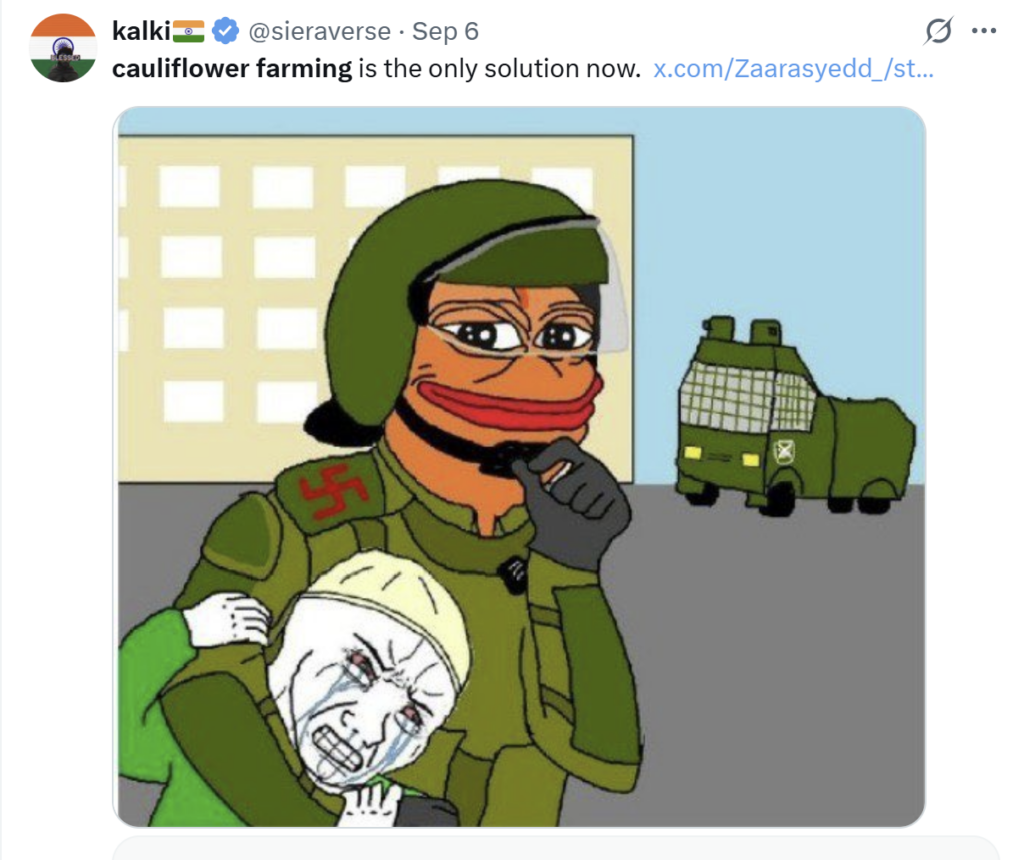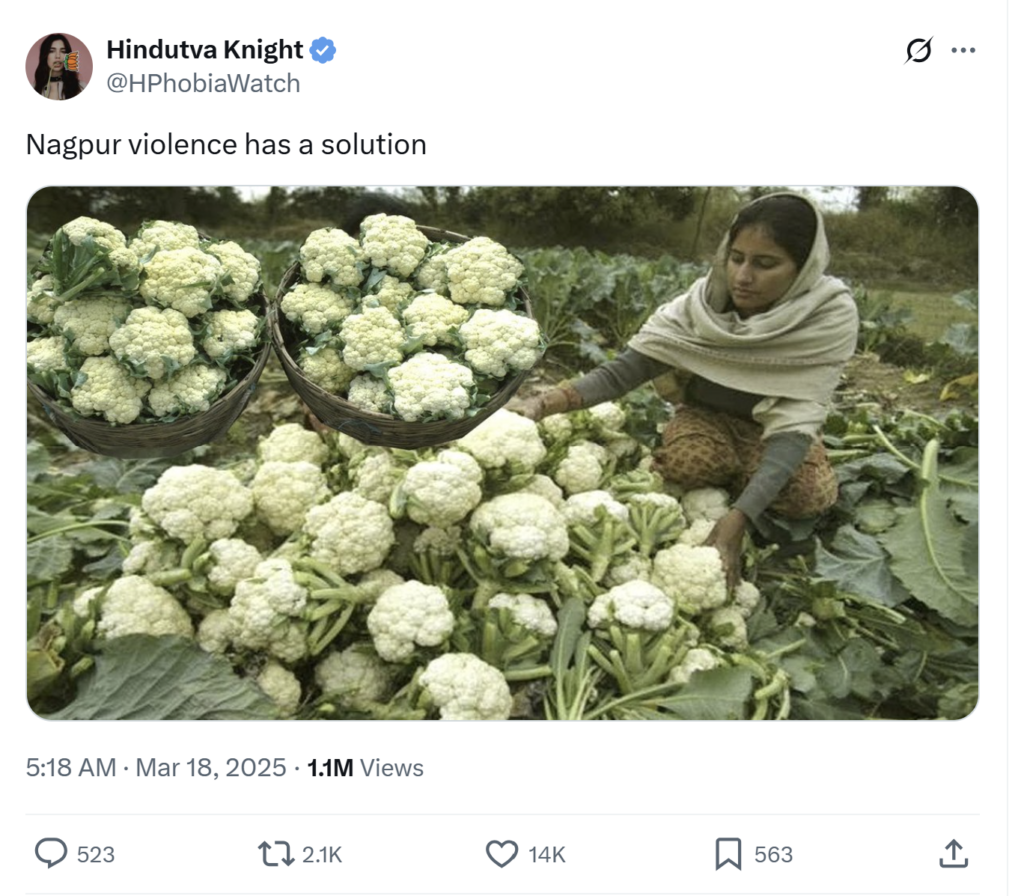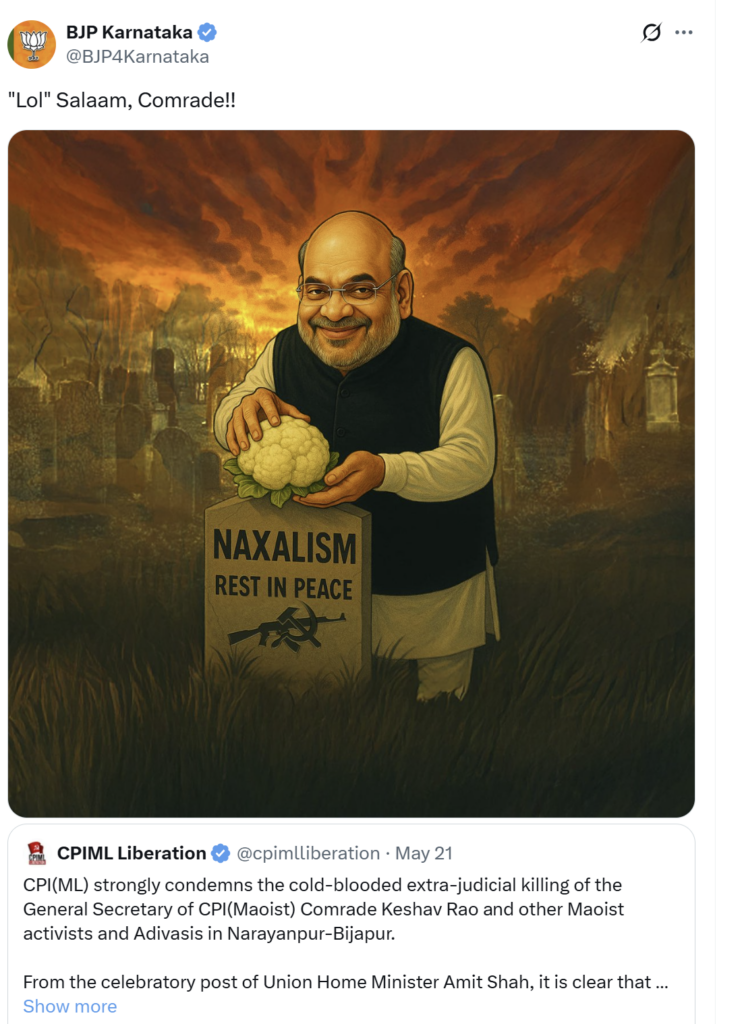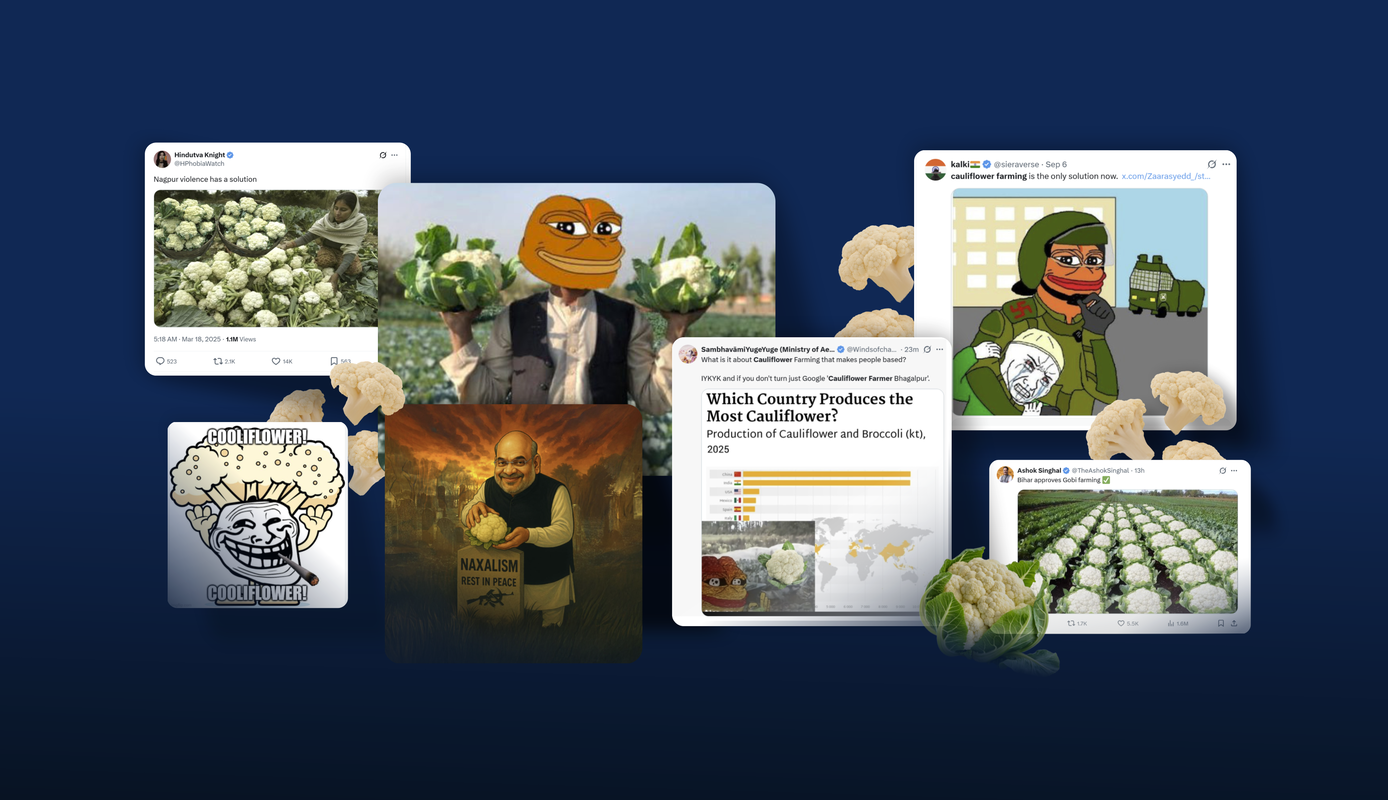Since Prime Minister Narendra Modi and the Hindu nationalist Bharatiya Janata Party (BJP) came to power in 2014, the online space has become central to shaping and amplifying a majoritarian nationalist discourse. Beyond the well-documented BJP troll networks, this dominance has cultivated a distinct Hindu nationalist, or Hindutva, culture that blends hyper-nationalism with irony, dark humor, and coded calls for violence.
Within this broader ecosystem, an extremist subculture has taken hold, marked by its glorification of brutality against minorities, its rejection of even mainstream political restraint, and its use of meme aesthetics to normalize bigotry. What is especially concerning is how this fringe subculture is increasingly bleeding into the political mainstream. Memes that openly reference violence against minority communities, including the now-viral “cauliflower” meme, have been circulated and celebrated by senior BJP leaders and many party-aligned accounts.
Its spread signals a troubling shift that violence is no longer framed merely as “security” or “self-defense,” but repackaged as humor and made socially acceptable. It also reflects the broader convergence between online extremism and institutional politics in India. While the cauliflower meme is an extreme example, it is emerging in a context where the state is increasingly permissive toward, and at times actively encouraging, the dehumanization of marginalized groups.

‘Cauliflower’ Farming
The cauliflower meme specifically references the 1989 communal violence in the Bhagalpur district of Bihar. Over a thousand people were killed in the riots, the vast majority of them Muslims, as part of the Ram Temple-Babri Mosque dispute that shook northern India. In the village of Logain, a mob led by the police officer Ramachander Singh killed 116 Muslims. Singh and his co-conspirators attempted to hide the bodies under cauliflower and cabbage fields, a crime later uncovered by investigators. In 2007, an Indian court convicted and jailed Singh and 13 others for their role in the massacre.
Among some supporters of the Hindu nationalist movement, Singh and his actions were seen as commendable. A Hindu nationalist Facebook group, the Hindu Rashtra Bharat, cheered on the elimination of hundreds of “pests” who, in their view, mercilessly attacked Hindus until they had enough and retaliated. In describing the actions, the group remarked that “due to the rich quality of the natural fertilizer mixed with the soil, the cauliflowers grown in Bhagalpur are of superior quality and taste”.
The meme itself has been gaining steady popularity over the past few years. The earliest known instance appeared on Imgflip four years ago from an anonymous account. At the time, the narrative had already gained enough traction that online users had begun adopting the label “cauliflower farmer” as a badge of affiliation among certain far-right accounts celebrating the violence.

By 2022, as ideological splits between relatively moderate “raitas” and hard-line “trads” became more visible, the cauliflower meme increasingly surfaced in factional online battles. Its mainstream visibility expanded further in 2025 during communal riots in Nagpur, Maharashtra, when supporters revived the imagery to imply the need for “a solution”, a euphemism instantly recognizable to those who understood its historical reference.
The meme itself often appears deceptively benign: simply a photograph of a cauliflower field, or a user proclaiming support for “cauliflower farming.” To outsiders, it reads as harmless agricultural content. For in-group audiences, however, it functions as a coded endorsement of anti-Muslim violence, one that relies on shared knowledge of the Logain massacre and its digital afterlives.
This coded vocabulary grants users a form of plausible deniability. They can circulate messages steeped in genocidal intent while appearing innocuous to platforms, casual observers, and even automated moderation systems. The effect is evident in a simple search for “cauliflower farming” on platforms like Instagram, where genuine agricultural posts sit alongside content that quietly celebrates mass violence. This deliberate blending blurs the boundaries between everyday imagery and extremist signaling, allowing violent rhetoric to remain both visible to insiders and invisible to those outside the ecosystem.

The Online Hindu Nationalist Ecosystem
Among India’s political currents, the broader Hindu nationalist movement dominates the country’s social media landscape. Within this online ecosystem, however, exists a far more extreme subculture: “trads” [traditionalists] who eschew the “mainstream” norms.
Unlike many Hindu nationalist supporters, “trads” view Prime Minister Modi and the ruling establishment as insufficiently hardline, often accusing them of being “pro-Muslim.” In contrast to the comparatively moderate faction known as “rayta/raita” (a term drawn from raita phailana, meaning “to create a mess”), the “trads” are far more explicit in their calls for violence against Muslims, political opponents, and anyone they deem an obstacle to their vision of Hindu supremacy.
Despite their contempt for the raita faction, “trads” have exerted outsized influence in shaping the mainstream Hindu nationalist narrative on social media. Many self-identified “raitais” acknowledge the excesses and “flaws” of the trads, yet ultimately see them not as adversaries but as overzealous allies, misguided in their attacks on fellow Hindu nationalists, but aligned in their broader ideological project.
In 2021, my co-authors and I conducted a comparative study of memes emerging from three reactionary online cultures: Hindu nationalist networks, supporters of the shooter Kyle Rittenhouse, and neo-Nazi communities. Whereas pro-Rittenhouse and neo-Nazi memes overwhelmingly celebrated or explicitly called for violence against their outgroups, Hindu nationalist memes more commonly framed Muslims as an existential threat to Hindus rather than glorifying violence directly.
However, we noted that reference to the perceived out-group is not itself disconnected from the desire to justify or to commit violence against the out-group. In other words, violence could be justified by supporters as a necessary measure to protect the Hindu community. This dynamic has played out repeatedly offline.
In December 2017, Shambu Lal Raigar hacked a Muslim man to death, set his body on fire, and uploaded a video of the killing. Raigar justified the murder through the Hindu nationalist conspiracy theory of “love jihad,” claiming he was acting preemptively to protect Hindus from supposed predation by Muslim men. Local Hindu nationalist groups celebrated Raigar, framing the killing as heroic and insisting that “love jihad” posed a grave threat to Hindu women and, by extension, to the Hindu community.
Mainstreaming of ‘Cauliflower’ Meme
Despite the trads’ hostility toward the comparatively moderate “raitas,” elements of trad discourse, most notably the cauliflower meme, have begun to migrate into the Hindu nationalist mainstream. In May 2025, after Indian police forces killed Naxalite leader Keshava Rao, the Karnataka branch of the BJP circulated the cauliflower meme on its official social media accounts.

After the BJP-led National Democratic Alliance (NDA) victory in the Bihar elections in November 2025, a BJP cabinet minister in the northeastern state of Assam shared a meme that read, “Bihar approves of Gobi [cauliflower] farming.” It is a deeply concerning development when a meme that glorifies and celebrates brutal violence becomes increasingly accepted within the political mainstream. The routine dehumanization of Muslims by social media influencers, politicians, and traditional media personalities creates the conditions in which such rhetoric can flourish and sets the stage for further violence.

Dehumanization plays a central role in justifying violence or harsher policies against perceived enemies and threats. The cauliflower meme in India exemplifies this process: a pro-violence symbol born in a fringe subculture has steadily entered mainstream discourse, amplified even by national political figures.
Tech platforms must adapt their content moderation systems to detect evolving coded language, especially when extremist users weaponize it as a call to violence. Most major platforms prohibit content that glorifies, incites, or expresses a desire for violence, and in many of the examples discussed above, the cauliflower meme clearly meets those thresholds. The problem is compounded by the fact that some of the accounts circulating such content on X hold blue checkmarks, giving their posts algorithmic amplification and wider reach. Without decisive action on the part of social media platforms, the risk of online dangerous speech translating into offline violence will only continue to grow.
(Hari Prasad is a research associate at Critical Research and Analysis, where he focuses on Middle Eastern and South Asian Politics and Security, particularly on armed actors, religious movements, and political violence.)
